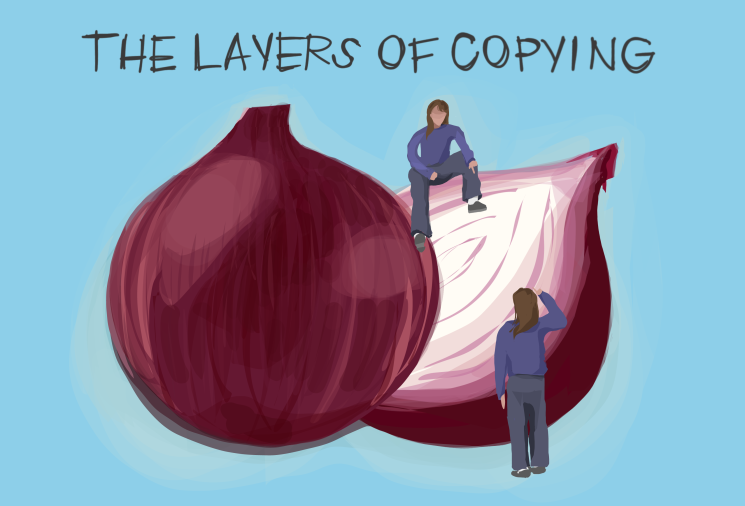
By Emily Chan
Copying is known as the highest form of flattery. And in many ways this is true. I mean, what’s a better indicator of your good character than someone trying to act and dress like you? That said, while it does make sense, that doesn’t make being copied any less annoying.
But copying is complex, like the layers of an onion, a big ol’ copycat’s onion. Below I’ve broken down the stages of copying into five layers of an onion. The first two layers
Layer 1
This layer is shiny, smooth and surface level. This form of copying doesn’t have any evil intent behind it. It’s more of a means of establishing a closer bond with you, rather than trying to become you. We all copy each other, that’s simply a fact. Your friend starts using some new slang, and you pick it up. Or your friend has a cool sense of style, and you start to dress similarly too. People often take inspiration from those close to them to find belonging. In essence, this first layer can be categorized as innocent imitation.
Layer 2
As this layer is exposed, so are the questions. This is the stage of questions and inspiration. It can be as simple as someone asking “I love your skirt, where did you get it?” People normally ask questions about the origin of things, oftentimes clothing items or accessories to learn a bit more about you. In fact, plenty of great conversations can take place just because of questions like these. So, it’s still unnecessary to point fingers and accuse someone of copying you simply because someone is asking questions. The reason why this layer still comes after imitation to form bonds is that these questions are a gold mine of information for any copycat looking to imitate you. Where things get difficult is when the worm of consciousness begins to peek its head out of the onion when people utilize the information on the roots of your personal items to their advantage.
Layer 3
The third layer of your copycat’s onion is seen as the “twinning” phase. It’s safe to say that this layer is still more or less harmless. Sometimes people deliberately match simply for novelty, or you may match unintentionally. You and your friend may purchase similar pencil cases or cardigans one day and accidentally be twinning a few days after. Oftentimes twinning with someone is a result of similarities in style and taste. It’s fine to go to the store, see something that reminds you of someone you know or have seen and get it. But it gets a bit dicey when you think to yourself, I’m going to buy this piece of clothing because I want to be like someone.However, this stage marks the hovering over the thin red line that divides similarity and copying.
Layer 4
This is true identity theft. Of course, I’m saying this is for dramatic purposes only, but this form of copying is truly the most annoying of them all. The person copying is simply way too inspired by you that they want to turn into you, or as close to you as they can possibly get. The fourth layer of copying can be characterized as a two-stage process that consists of replication and denial. It typically goes something like this:, they see you wear a unique outfit, buy those pieces and post a picture saying “Being creative with my clothing feeds my soul.”. Here they replicated your outfit and denied that you created it by saying it was out of their own creativity.
But why do people do this? The simple answer is that copycats try to replicate the likeness of another person out of insecurity. They have such a weak sense of self that when they see someone they look up to, they believe that being like them is the answer to their problems. I mean, if they acted like their confident friend, wouldn’t they be confident as well? But in the end, it’s just like putting on a bandaid in the shower. It just doesn’t stick.
But never fear, this stage can be fixed. James Clear once said in his book Atomic habits, a book about transforming your habits, that people imitate the close, the powerful and the many.
Maybe you’re not in a position of authority or can’t clone yourself to become “the many,” but there’s no doubt that you ARE close to the person copying you. Because of this, the best option for you is to distance yourself so long you want to prevent the copycat from morphing into your doppelgänger.
Layer 5
This last layer is what really makes your eyes sting and tear up. It’s smelly and no longer falls under the category of copying for attention or out of insecurity in oneself, but purely out of greed. It’s often that large companies and corporations live under this umbrella of copying. Commonly, large companies such as Shein will replicate the work of smaller artists or designers and SELL IT. It’s no longer a question of coincidence here, but a question of morals. This form of copying is the most malicious because the purpose of it is to make a profit. And this works because who needs a real designer for your products when you can just do a little scroll on Instagram and copy and paste an artist’s work onto your own website?
Conclusion
When copying is taken too far, it turns from being annoying to just downright weird. Whether it’s out of insecurity or out of greed, copying is certainly not a friendly concept. In order to put a halt to being copied, we must be ok with confrontation and distancing ourselves from people that make us uncomfortable.





